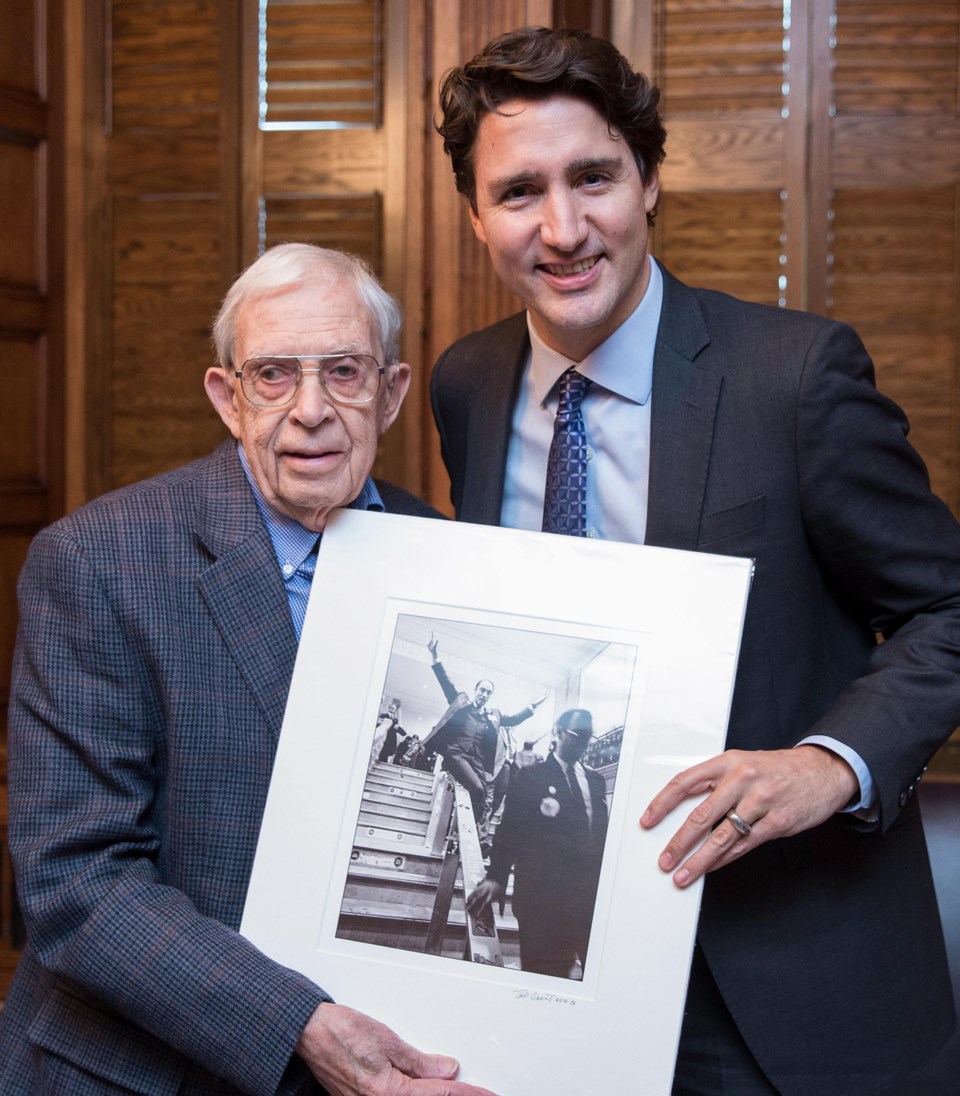Back in his newspaper days, Victoria’s Ted Grant used to photograph Order of Canada ceremonies at Rideau Hall.
On Friday, the 86-year-old was the subject, not the shooter.
“I kept thinking: ‘This is a dream and I’m going to wake up,’ ” he said, on the phone from Ottawa shortly after being invested as a member of the order.
Grant is one of those people who thinks less of himself than others do. “I’m just me and the camera is part of me,” he said. “I see things and I click.”
Others will tell you that no, he’s a big deal.
“Everyone calls him the godfather of photojournalism in Canada,” says Tofino photographer Deddeda White. “He’s a legend.”
A legend whom you might not recognize on the streets of Victoria, where he has lived since 1981, but whose images you surely know, whether from Vietnam, the Six-Day War, or a succession of Olympic Games.
His 1968 picture of Pierre Trudeau sliding down a banister is called the most iconic Canadian political photo ever. His shot of soon-to-be-disgraced sprinter Ben Johnson, muscles rippling, arm raised in triumph while powering past archrival Carl Lewis at the 1988 Seoul Olympics, was an instant classic.
Grant is the winner of too many awards to list, the author or co-author of eight books, the subject of books and documentaries. The national archives keep close to 300,000 of his images, the largest collection dedicated to a single photographer.
Not bad for a guy who can only use one eye. A childhood vision problem means the world comes to him in two dimensions, not three. “What he sees is basically a picture,” said his photographer son Scott.
It was Scott’s mother and Ted’s wife, Irene — now gone — who gave Ted his first camera, an Argus A2, on May 27, 1950.
That launched a career that took him from his first published photo in the Ottawa Citizen in 1951 to pictures of Jackie Kennedy, the children of Chernobyl and Spanish bullfights. He has yet to retire.
“It’s never been work,” Grant said Friday. “It has been like a fantastic love affair.”
He once used that line in a speech attended by Irene. “How would you know what a love affair is like?” she piped up. White said they adored each other.
White also said Grant, her friend and mentor, taught her to see the world in a different way.
“He can catch all these slice-of-life moments that are so beautiful. It’s all about the light.”
Grant is quick to say he’s less of a techie than many photographers. “Shoot what’s there. I don’t analyze everything like other people.”
He works for his shots, though. A book published by the national archives described the background to the Ben Johnson picture: “It was not a matter of luck and motor drive to record the moment of victory of a race that lasted less than 10 seconds. Grant studied the track during the heats the day before the final, then claimed a vantage point on a low wall near the finish line five hours before the race began.”
A few years ago, Grant told me how he got the picture of Trudeau, whom he was tracking for Weekend Magazine during the race to succeed Lester Pearson as Liberal leader and prime minister.
As Trudeau left Ottawa’s Chateau Laurier, the rest of the press corps went outside to wait on the sidewalk. Not Grant. When photographing individuals, he always liked to stay close, 10 to 15 feet away.
Grant was heading down the stairs, his back to Trudeau, when he heard laughter. Spinning around, he had just enough time to get one in-focus shot of Trudeau sliding down the banister. Two more frames were out of focus. “The third one, he was practically on top of me.”
Meanwhile, the other photographers were scrambling to get back inside, but were crushed against glass doors that only swung outward. “I just got lucky,” Grant said. Right, like Gretzky got lucky, a lot.
He wasn’t the only Victorian on Friday’s Order of Canada list.
Leah Hollins, the chairwoman of Canadian Blood Services and a former B.C. deputy health minister, was recognized for her contributions to health care, including her efforts to improve organ donation.
Brentwood Bay’s Sandra Scarth is credited with improving the lives of thousands of children through her work on adoption and foster care. Good for them.
Grant’s honour struck a chord, though. Always humble, always generous to aspiring photographers (he is as legendary for his kindliness as for his work), he deserved to be on the other side of the lens.



